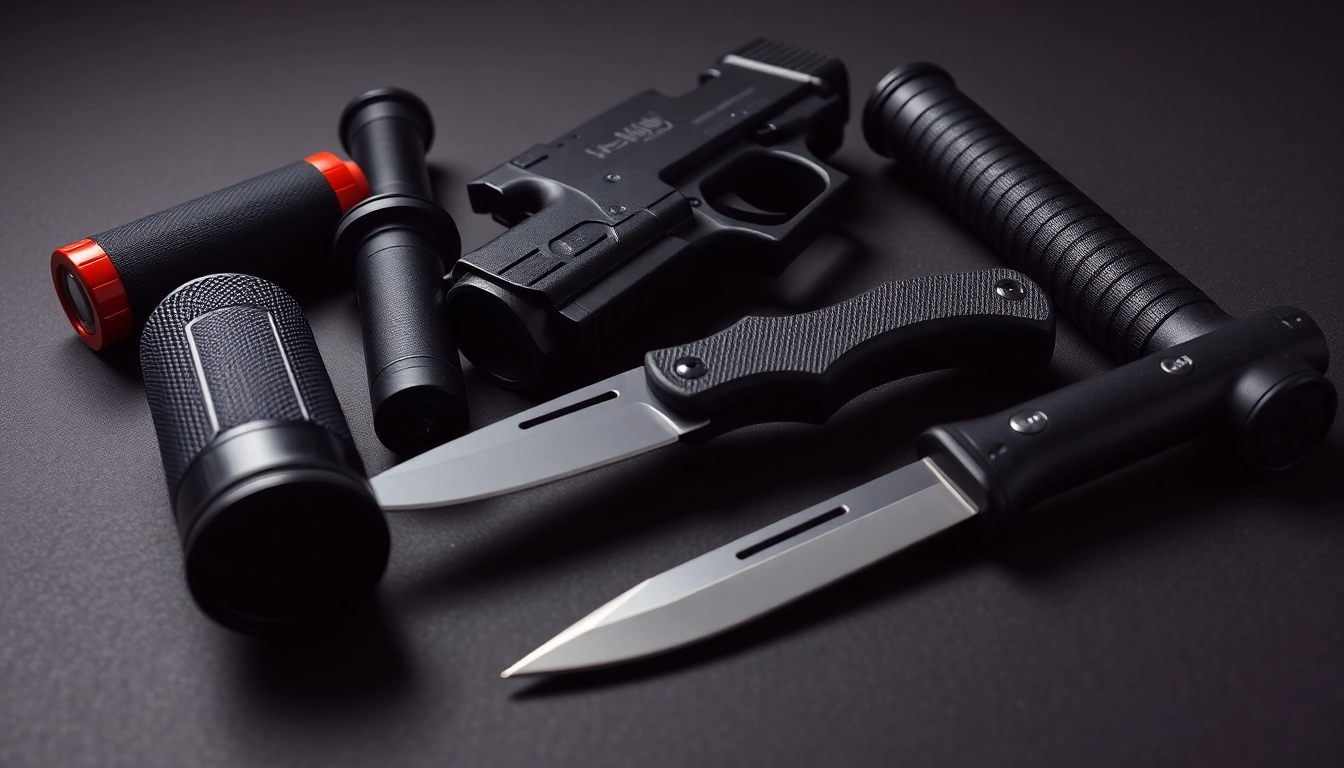
Effective Self-Defense Weapons for Personal Safety and Legal Use
Understanding Different Types of Self-Defense Weapons
In an era where personal safety continues to be a paramount concern, understanding the landscape of self-defense weapons is vital for anyone seeking to protect themselves, their loved ones, or their property. The availability of a variety of options—from non-lethal devices like pepper spray and personal alarms to lethal weapons such as concealed handguns and knives—means individuals can select tools best suited to their lifestyle, comfort level, and legal constraints. For those interested in exploring comprehensive options, learn more about Self-Defense Weapons to make informed decisions tailored to your protection needs.
Non-Lethal Devices: Pepper Spray, Tasers, and Personal Alarms
Non-lethal self-defense devices are popular choices for individuals who prioritize safety without risking legal or ethical complications associated with lethal weapons. These tools incapacitate or deter threats temporarily, giving victims a chance to escape or call for help. Among the most recognized are pepper sprays, tasers, and personal alarms.
Pepper Spray is a contact chemical spray that causes intense eye irritation, difficulty breathing, and skin inflammation. It has an effective range of up to 10 feet, allowing users to maintain distance from an attacker. Pepper sprays are legal in most states, often requiring minimal or no permits, but regulations vary, so it’s essential to research local laws.
Tasers and stun guns deliver an electric shock that temporarily incapacitates an attacker. A taser can fire darts attached to wires, reaching out to immobilize a threat from several feet away, whereas stun guns involve direct contact. They are non-lethal but require proper handling to ensure effective use and safety.
Personal alarms are compact devices that emit loud, piercing sounds when activated, drawing attention and deterring assailants. They are especially advantageous because they require no physical contact and are generally legal in all jurisdictions. Incorporating personal alarms into everyday carry routines can significantly increase perceived safety, serving as a simple yet powerful self-defense tool.
Lethal Options: Concealed Handguns and Knives
Lethal self-defense options include firearms and knives, used in situations where personal safety is immediately threatened and non-lethal measures might not suffice. These tools demand high responsibility, proper training, and adherence to strict legal regulations.
Concealed handguns are among the most commonly carried self-defense weapons, especially for those trained in firearm safety. Their effectiveness relies on proper concealment, quick accessibility, and understanding of local firearm laws. In many jurisdictions, concealed carry permits are required, and training courses are mandated to ensure responsible usage.
Knives serve as versatile self-defense weapons, often carried as part of everyday tools like pocket knives or tactical blades. They are quick to deploy and can be highly effective at close range. Due to their potential lethality and regional restrictions, proper legal understanding and training are vital before choosing knives as a primary self-defense tool.
Discreet and Innovative Weapons for Discreet Self-Protection
Modern self-defense tools are increasingly designed to be discreet and portable, fitting seamlessly into daily life without attracting undue attention. Examples include disguised keychains, lipstick tasers, or everyday objects converted into defensive tools. Such items enable individuals to carry protection devices confidently, especially in situations where overt weapons might be inappropriate or illegal.
For example, a self-defense keychain—often containing a small pepper spray container or emergency alarm—can be clipped onto a bag or keyring, blending into daily routines. Similarly, personal security devices disguised as jewelry or wallet cards prevent conspicuous carry, facilitating quick access when needed.
Legal Considerations and State Regulations
What Self-Defense Weapons Are Legal in the U.S.?
The legal landscape of self-defense weapons in the United States varies significantly by state, city, and even county. Generally, non-lethal tools such as pepper spray, personal alarms, and stun guns are legal at the federal level, but local laws can impose restrictions—such as limits on spray size or stun gun voltage. Firearms and knives may require permits, background checks, or have specific restrictions based on blade length or firearm classification.
To navigate this complex legal terrain, it is crucial to consult local laws and regulations before acquiring or carrying any self-defense weapon. Notably, some states, like California and New York, have stringent restrictions on certain devices, while others, like Texas and Florida, tend to have more permissive policies.
How to Legally Carry Self-Defense Weapons
Legal possession is only part of safe self-defense practices. Carrying laws encompass how, where, and when you can carry these tools. For example, some weapons require concealed carry permits, while others are freely portable in public. Proper documentation, such as permits for firearms or knife registrations, is necessary in many jurisdictions.
Training and understanding the legal boundaries of self-defense are equally important. Carrying a weapon without awareness of the local restrictions might lead to legal repercussions, even if your intent is self-protection. Always keep updated with legislation changes and obtain necessary permits to ensure compliance and personal safety.
Important Permits and Restrictions for Self-Defense Tools
Permits are often required for firearms, certain knives, and larger stun devices. For example, concealed carry licenses are mandatory in many states for handguns, and some jurisdictions prohibit the carry of certain types of knives or switchblades. Restrictions may also include age limits, background checks, or mandatory safety courses.
Understanding these permits and restrictions can prevent legal issues and ensure your safety. Regional agencies, state government websites, and law enforcement offices are valuable resources for acquiring accurate, current information regarding self-defense weapon regulations.
Choosing the Right Self-Defense Weapon for Your Needs
Factors to Consider: Size, Ease of Use, and Concealability
When selecting a self-defense weapon, personal factors heavily influence the most suitable choice. Size and weight determine portability and ease of carry—compact devices like keychain alarms or small sprays are ideal for daily use, while larger weapons might be reserved for home defense.
Ease of use is another critical factor. Devices should be intuitive to operate under stress, with quick access and straightforward activation. Consider also the user’s physical abilities; a senior might prefer a lightweight stun gun, whereas a younger individual might opt for a more versatile pepper spray or knife.
Concealability ensures that the weapon can be carried without attracting attention, increasing the likelihood that it will be available in an emergency. The best self-defense weapon balances these factors in accordance with individual lifestyle and comfort level.
Self-Defense Weapons for Women and Seniors
Women and seniors often require specialized self-defense tools that prioritize safety, ease of operation, and discretion. Women’s self-defense products tend to combine style and functionality, such as fashionable stun guns, pepper sprays disguised as lipstick, and compact personal alarms. These products are designed to be carried easily in handbags or pockets and to be operated with minimal effort.
Seniors may prefer ergonomic, easy-to-use devices like stun guns with large grips, canes equipped with concealed weapons, or keychain pepper sprays. Educational resources and training tailored to these groups enhance effectiveness and confidence, making self-defense tools more than just possessions—they become integral parts of their personal safety routines.
Best Practices for Training and Proper Use
Owning a self-defense weapon is only effective if it is used properly. Regular training sessions help build muscle memory, or the instinctive response needed during high-stress situations. Many manufacturers and security organizations offer courses that teach proper deployment, aiming, and situational awareness.
Practicing with training devices—such as inert sprays or simulators—can reduce hesitation and improve reaction times. Education on legal considerations, ethical use, and consequences ensures responsible ownership. Remember, the key to effective self-defense is not just having the right tools but knowing how and when to use them appropriately.
How to Effectively Use Self-Defense Weapons in an Emergency
Preparation and Situational Awareness
Effective self-defense begins long before an attack occurs. Cultivating situational awareness allows you to recognize threats early, giving you critical seconds to react. Avoid distractions, plan routes carefully, and stay alert in unfamiliar environments.
Preparation includes regularly checking your self-defense devices—ensuring pepper spray is functional, stun guns are charged, and alarms are operational. Storing your safety tools in accessible locations ensures rapid deployment when needed.
Step-by-Step Guidance on Self-Defense Scenarios
In an emergency, clarity and calmness are vital. Here’s a simplified guide:
- Assess the situation: Determine if escape is possible or if defense is necessary.
- Activate your chosen device: For pepper spray or alarms, aim at the attacker and spray or activate promptly.
- Maintain distance: Use your weapon to create space—step back or move to a safer location.
- Seek help: Call emergency services immediately and provide your location.
- Follow up: Seek medical attention if needed and report the incident to authorities.
Maintaining and Charging Your Self-Defense Devices
Maintenance prolongs the effectiveness of your self-defense tools. Regularly verify the integrity of sprays, ensure stun guns and tasers are fully charged, and replace batteries as recommended. Store devices in a dry, accessible location, and inspect for damage or leaks periodically.
Proper care guarantees readiness, so your self-defense arsenal is always prepared to function precisely when demanded.
Performance Metrics and Safety Tips
Assessing Effectiveness and Range
Understanding the reach and potency of your self-defense weapons is crucial. For example, pepper sprays typically have effective ranges of 6-10 feet, while stun guns can deliver powerful shocks instantaneously upon contact. Firearms, depending on caliber and barrel length, can have ranges from 25 yards to several hundred yards.
Test your devices in controlled environments to familiarize yourself with their operational range, spray dispersion, and impact. Keeping track of these metrics aids in selecting the right tools and using them effectively during an emergency.
Safety Tips for Storage and Transportation
Safe storage is fundamental to prevent accidental discharge or misuse. Store weapons in locked safes or cabinets, especially if children or unauthorized persons have access. Keep pepper sprays and stun guns away from heat and direct sunlight to prevent deterioration.
When transporting self-defense weapons, adhere to state and federal laws, often requiring concealment and secure storage. Ensure your devices are turned off or safely stored during travel to prevent mishaps and legal issues.
Legal and Ethical Responsibility When Using Self-Defense Weapons
Responsibility extends beyond possession; ethical use of self-defense tools demands proportionality and necessity. Use only the amount of force justified by the threat, and avoid escalation or unnecessary harm. Document incidents when possible, and cooperate with law enforcement authorities.
Training on legal self-defense practices safeguards you legally and promotes responsible ownership that respects the rights and safety of others.


